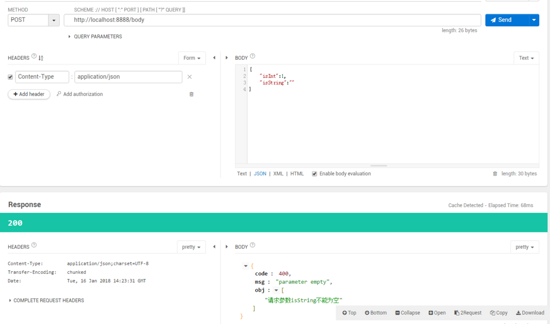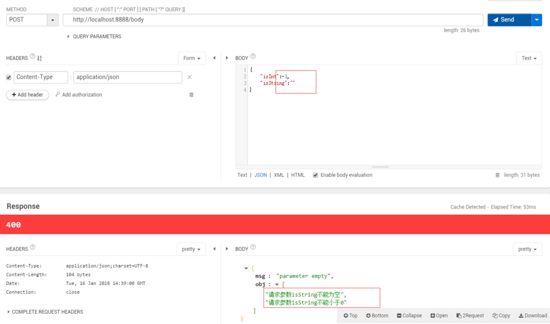why:
为什么要用aop实现校验?
answer:
spring mvc 默认自带的校验机制 @valid + bindingresult, 但这种默认实现都得在controller方法的中去接收bindingresult,从而进行校验.
eg:
|
1
2
3
4
5
6
7
|
if (result.haserrors()) { list<objecterror> allerrors = result.getallerrors(); list<string> errorlists = new arraylist<>(); for (objecterror objecterror : allerrors) { errorlists.add(objecterror.getdefaultmessage()); } } |
获取errorlists。这样实现的话,每个需要校验的方法都得重复调用,即使封装也是。
可能上面那么说还不能表明spring 的@valid + bindingresult实现,我先举个“栗子”。
1. 栗子(旧版本)
1.1 接口层(idal)
eg: 简单的post请求,@requestbody接收请求数据,@valid + bindingresult进行校验
- httpmethid: post
- parameters:@requestbody接收请求数据
- valid:@valid +bindingresult
|
1
2
3
4
5
6
7
8
9
10
11
12
13
14
|
@responsebody @postmapping("body") public responsevo bodypost(@requestbody @valid testvo body,bindingresult result){ //校验到错误 if (result.haserrors()) { list<objecterror> allerrors = result.getallerrors(); list<string> lists = new arraylist<>(); for (objecterror objecterror : allerrors) { lists.add(objecterror.getdefaultmessage()); } return new responsevo(httpstatus.bad_request.value(), "parameter empty", lists); } return new responsevo(httpstatus.ok.value(), "bodypost", null);} |
1.2 实体(vo)校验内容
@valid + bindingresult的校验注解一大堆,网上一摸就有的!
|
1
2
3
4
5
6
7
8
9
10
|
public class testvo { @getter @setter @min(value = 0,message = "请求参数isstring不能小于0") private integer isint; @getter @setter @notblank(message = "请求参数isstring不能为空") private string isstring;} |
1.3 结果测试

2. aop校验(升级版)
可以看到若是多个像bodypost一样都需要对body进行校验的话,那么有一坨代码就必须不断复现,即使改为父类可复用方法,也得去调用。所以左思右想还是觉得不优雅。所以有了aop进行切面校验。
2.1 接口层(idal)
是的!你没看错,上面那一坨代码没了,也不需要调用父类的的共用方法。就单单一个注解就完事了:@paramvalid
|
1
2
3
4
5
6
|
@paramvalid@responsebody@postmapping("body")public responsevo bodypost(@requestbody @valid testvo body,bindingresult result){ return new responsevo("bodypost", null);} |
2.2 自定义注解(annotation)
这个注解也是简简单单的用于方法的注解。
|
1
2
3
|
@target(elementtype.method)@retention(retentionpolicy.runtime)public @interface paramvalid {} |
2.3 重点!切面实现(aspect)
切面详解:
@before: 使用注解方式@annotation(xx),凡是使用到所需切的注解(@paramvalid),都会调用该方法
joinpoint: 通过joinpoint获取方法的参数,以此获取bindingresult所校验到的内容
迁移校验封装: 将原先那一坨校验迁移到aspect中:validrequestparams
响应校验结果:
- 通过requestcontextholder获取response
- 获取响应outputstream
- 将bindingresult封装响应
|
1
2
3
4
5
6
7
8
9
10
11
12
13
14
15
16
17
18
19
20
21
22
23
24
25
26
27
28
29
30
31
32
33
34
35
36
37
38
39
40
41
42
43
44
45
46
47
48
49
50
51
52
53
54
55
56
57
58
|
@aspect@componentpublic class paramvalidaspect { private static final logger log = loggerfactory.getlogger(paramvalidaspect.class); @before("@annotation(paramvalid)") public void paramvalid(joinpoint point, paramvalid paramvalid) { object[] paramobj = point.getargs(); if (paramobj.length > 0) { if (paramobj[1] instanceof bindingresult) { bindingresult result = (bindingresult) paramobj[1]; responsevo errormap = this.validrequestparams(result); if (errormap != null) { servletrequestattributes res = (servletrequestattributes) requestcontextholder.getrequestattributes(); httpservletresponse response = res.getresponse(); response.setcharacterencoding("utf-8"); response.setcontenttype(mediatype.application_json_utf8_value); response.setstatus(httpstatus.bad_request.value()); outputstream output = null; try { output = response.getoutputstream(); errormap.setcode(null); string error = new gson().tojson(errormap); log.info("aop 检测到参数不规范" + error); output.write(error.getbytes("utf-8")); } catch (ioexception e) { log.error(e.getmessage()); } finally { try { if (output != null) { output.close(); } } catch (ioexception e) { log.error(e.getmessage()); } } } } } } /** * 校验 */ private responsevo validrequestparams(bindingresult result) { if (result.haserrors()) { list<objecterror> allerrors = result.getallerrors(); list<string> lists = new arraylist<>(); for (objecterror objecterror : allerrors) { lists.add(objecterror.getdefaultmessage()); } return new responsevo(httpstatus.bad_request.value(), "parameter empty", lists); } return null; }} |
2.4 测试结果

看了上面两种结果,就可以对比出使用spring aop 配合@valid + bindingresult进行校验的优点:
- 去除代码冗余
- aop异步处理
- 优化代码实现
以上就是本文的全部内容,希望对大家的学习有所帮助,也希望大家多多支持服务器之家。
原文链接:https://juejin.im/post/5a5e1159518825732b19d8ce















